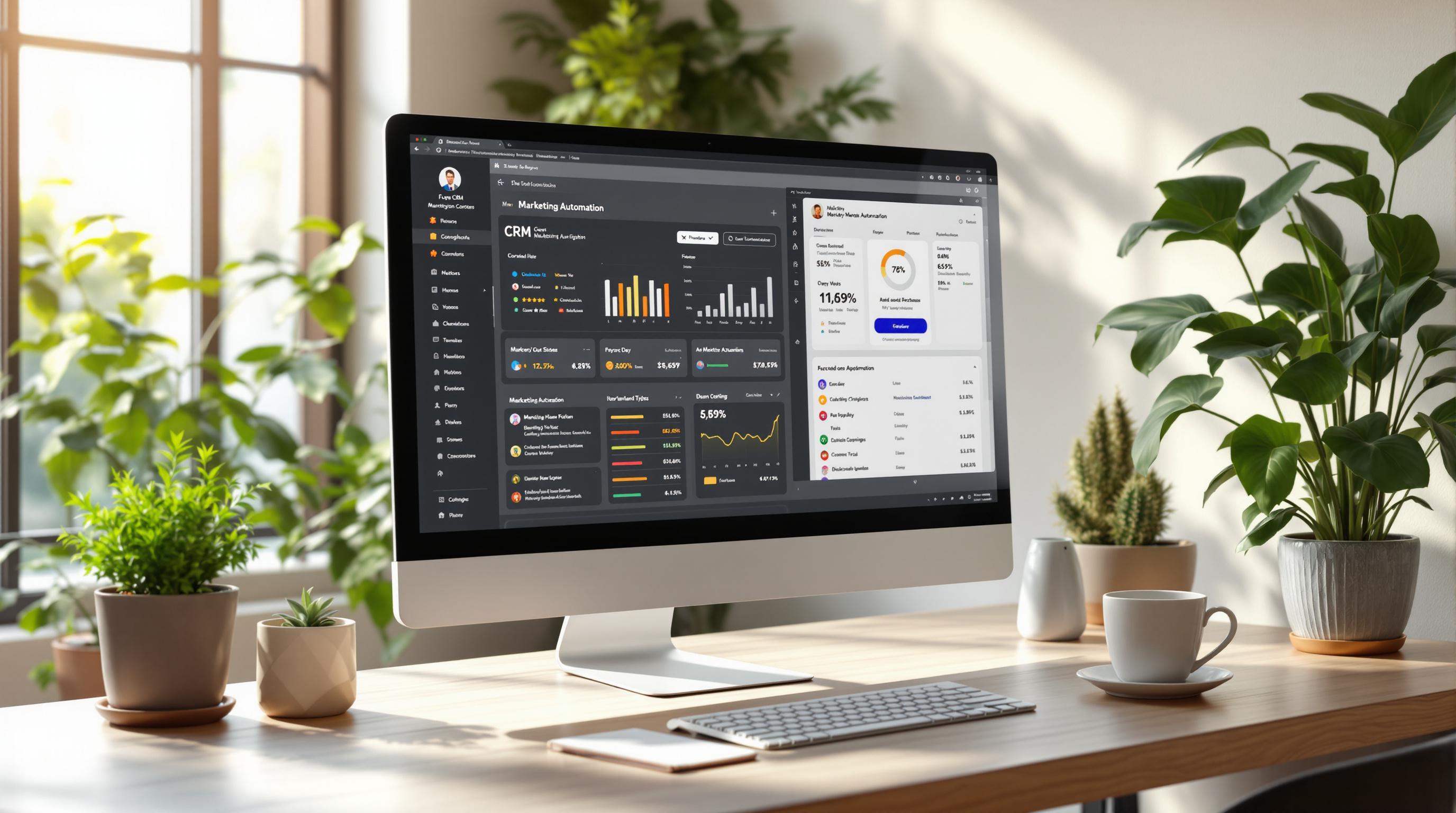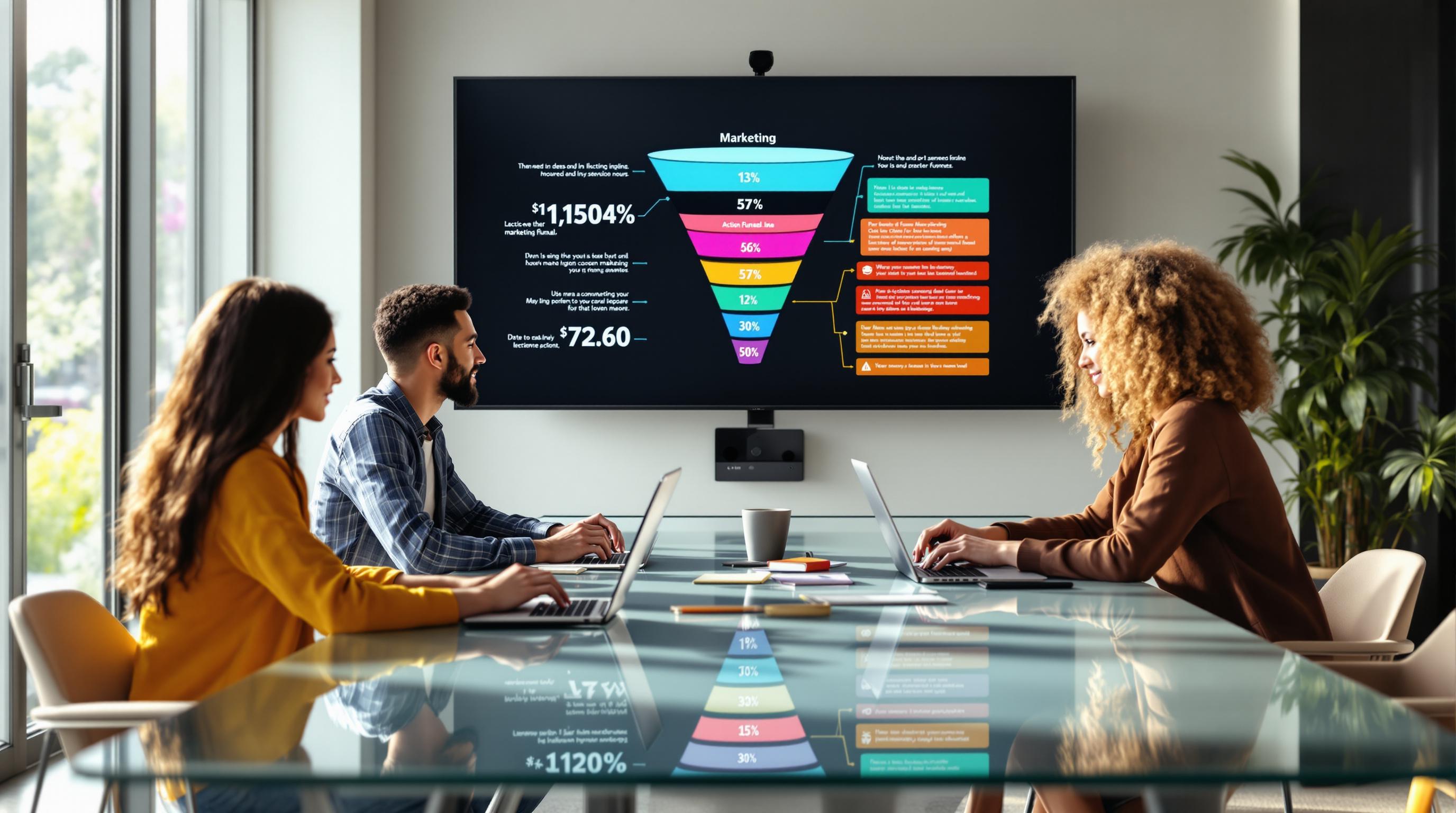Multivariate testing helps you improve your marketing funnel by testing multiple variables at once to find the best-performing combinations. Here's how you can optimize your funnel step by step:
-
Step 1: Choose Elements to Test
Identify key funnel parts (CTAs, headlines, forms) and set measurable goals like increasing signups or reducing cart abandonment. -
Step 2: Plan Test Variations
Create different versions of elements (e.g., form fields, CTA colors) based on clear hypotheses. Test one variable at a time for accurate results. -
Step 3: Set Up Testing System
Use testing software to split traffic evenly, track metrics, and ensure reliable results. -
Step 4: Execute the Test
Launch your test, monitor results (conversion rates, engagement, revenue), and account for external factors like seasonal trends. -
Step 5: Use Test Results
Analyze data to identify what works, implement changes gradually, and plan future tests to refine your funnel further.
Quick Overview of Funnel Stages:
| Stage | Key Metrics | Common Issues |
|---|---|---|
| Awareness | Traffic sources, bounce rate | Mismatch between message and audience |
| Interest | Time on page, scroll depth | Unclear value proposition |
| Consideration | Email signups, downloads | Overcomplicated forms, weak CTAs |
| Action | Purchase rate, cart completion | Confusing checkout process |
| Retention | Repeat purchase rate | Lack of follow-up or onboarding |
By following these steps, you can systematically improve your funnel to boost conversions and revenue.
A/B Testing vs Multivariate Testing - What's the Difference?
Step 1: Choose Elements to Test
Start by identifying the key parts of your funnel that could benefit from testing. A focused approach ensures you make changes that genuinely impact results.
Set Testing Goals
Define clear, measurable objectives that align with your business priorities. Examples include:
- Increasing email signup rates
- Lowering cart abandonment rates
- Improving the quality of leads
- Raising the average order value
Map Out Funnel Stages
Break down your funnel into stages to identify where testing can make the most difference.
| Funnel Stage | Key Metrics | Common Issues |
|---|---|---|
| Awareness | Traffic sources, bounce rate | Mismatch between message and audience |
| Interest | Time on page, scroll depth | Value proposition isn't clear enough |
| Consideration | Email signups, content downloads | Overcomplicated forms, weak CTAs |
| Action | Purchase rate, cart completion | Confusing checkout process, unclear pricing |
| Retention | Repeat purchase rate | Lack of follow-up, ineffective onboarding |
Choose Test Variables
Focus on elements that can significantly impact user behavior. Here are some ideas:
- CTAs: Experiment with text, color, size, and placement.
- Headlines: Adjust the value proposition, length, or formatting.
- Form Elements: Test field order, input types, and validation processes.
- Social Proof: Try different testimonials, trust badges, or ratings.
- Media: Swap out images, videos, or interactive content.
Consider how each variable fits into the user journey. For instance, tweaking form fields might work best for a B2B lead generation funnel, while testing product images could be more effective for an e-commerce site.
Step 2: Plan Test Variations
Once you've pinpointed the key elements to test, the next step is to create structured variations. This process helps ensure you can measure each variation's impact accurately and gain valuable insights to improve your funnel.
Write Test Hypotheses
Build clear, data-backed hypotheses by breaking them into these components:
- Observation: Identify a specific performance metric.
- Theory: Suggest a change that could influence the metric.
- Expected Outcome: Define the measurable result you anticipate.
- Success Metric: Pinpoint the key metric you'll use to measure success.
For example, if your lead generation form has a 25% completion rate, you might hypothesize: "Reducing the number of form fields from eight to five will increase the form completion rate."
Create Test Versions
Start by establishing a baseline (your current version) and record its performance metrics. Then, design variations that focus on changing one element at a time. This approach ensures you can isolate the effects of each change.
- Control: Your current version.
- Variation 1: A version with fewer form fields.
- Variation 2: A two-step form that incorporates social proof.
- Variation 3: An interactive, quiz-style form.
Keep each version focused on a single variable to maintain clarity in results.
Determine Test Size
Tailor your test size and duration to your website's traffic levels. For sites with lower traffic, test fewer variations over a longer period to collect sufficient data. High-traffic sites, on the other hand, can test multiple variations in a shorter timeframe. The goal is to gather enough visitors and conversions per variation to ensure your results are statistically reliable.
sbb-itb-a84ebc4
Step 3: Set Up Testing System
Once you've planned your test variations, the next step is to establish a system that ensures your multivariate tests run smoothly and deliver accurate, actionable results. A well-structured setup is key to collecting reliable data for improving your funnel performance.
Select Testing Software
Pick testing software that seamlessly integrates with your existing tools and offers detailed analytics. Look for software with features like:
- Real-time data visualization: Keep track of how your tests are performing as they run.
- Statistical significance calculator: Know when your results are valid and actionable.
- Segmentation tools: Break down results by different user groups.
- Integration options: Ensure it connects with your CRM and analytics platforms.
Pairing your CRM with marketing automation tools lets you track the customer journey from start to finish.
Split Traffic Evenly
Once your software is ready, distribute traffic evenly across your test variations. Here's how to manage the process:
- Start with a small portion - about 10% of your traffic - to catch any issues early.
- Gradually increase traffic to 25%, then 50%, as you confirm the system is stable.
- Regularly monitor traffic distribution to ensure all variations get comparable quality and volume.
Avoid making changes to traffic allocation during your test, as it can skew results.
Set Up Measurement
Define and track key metrics for each stage of your funnel. Here's a quick guide:
| Funnel Stage | Key Metrics | Tracking Method |
|---|---|---|
| Awareness | Page views, Time on page | Website analytics |
| Interest | Scroll depth, Engagement | Heat mapping tools |
| Consideration | Form starts, Chat usage | Event tracking |
| Conversion | Form completions, Sales | CRM integration |
Use visitor tracking to understand how different segments behave, which can guide future testing strategies.
If you're working with B2B funnels, make sure to track additional data points such as:
- Company details
- Frequency of visits
- Interaction patterns on key pages
- Conversion pathways
These insights will help you refine your testing and better understand your audience's behavior.
Step 4: Execute the Test
With your testing system ready, it's time to launch your multivariate test and start collecting data. This phase requires close attention to ensure everything runs smoothly and the results are dependable.
Start Testing
Set your test duration and scale before going live. Begin with a trial run to catch any technical glitches. Once everything checks out, launch the full test with the original version as your control. Keeping a control version allows you to make accurate comparisons and measure the impact of your variations.
Track Results
When the test is live, focus on these critical metrics:
- Primary conversion rate: Measure how well each variation achieves your main goal.
- Secondary metrics: Look at micro-conversions and engagement signals for additional insights.
- User behavior patterns: Use tools like heat maps and session recordings to understand how users interact with your variations.
- Revenue impact: Analyze how changes in conversion rates affect your revenue.
A real-time dashboard can help you quickly identify any major performance changes. Flag unusual patterns for further review after the test ends.
Check External Impact
Consider external factors that might influence your results. Keep an eye on:
- Seasonal trends: For example, higher conversion rates during holiday seasons.
- Marketing campaigns: Note any simultaneous efforts like email blasts, social media promotions, or paid ads that could skew results.
- Market changes: Watch for competitor moves, industry news, economic shifts, or updates from platforms that could impact your audience.
Document these external events to help interpret your findings within the right context.
Step 5: Use Test Results
Dive into your test results to pinpoint what works and make changes that improve your funnel's performance.
Identify What Works Best
Once you have your test data, focus on analyzing which elements performed the best. Here’s what to evaluate:
- Primary conversion metrics: Compare conversion rates across variations to find clear winners.
- Secondary engagement metrics: Check factors like time on page and click-through rates for additional insights.
- Revenue impact: Measure how much extra revenue the improved conversions bring in.
- Statistical confidence: Ensure your results are reliable and not due to chance.
You can use a performance matrix to visually compare the element combinations and uncover any unexpected patterns or interactions.
Update Your Funnel
Roll out the winning changes, but do it step by step to avoid disruptions:
- Record current metrics: Document your funnel's performance before making any changes.
- Gradual rollout: Start with a small audience segment to test the changes.
- Monitor closely: Keep an eye on performance during this phase to catch any issues early.
- Full implementation: Once you're confident in the stability of the new variation, roll it out to your entire audience.
Always keep the original version as a backup, and set up alerts to quickly spot any major shifts in performance.
Plan Future Tests
Use the insights from your current test to shape the next round of optimizations. Focus on:
- Funnel sections with the most potential for improvement
- Elements that showed promise but didn’t yield conclusive results
- Audience segments that might respond differently
- Adjusting test durations based on traffic trends
- Aligning success metrics with your overall business goals
- Tackling current bottlenecks in the conversion process
- Insights from user feedback and behavioral analytics
Continuous testing and refinement are key to keeping your funnel performing at its best.
Conclusion
Multivariate testing helps fine-tune funnels to achieve better conversion rates. When done methodically, it uncovers the factors that most influence customer decisions.
Key Takeaways
To carry out effective multivariate testing, focus on these crucial steps:
- Choose Wisely: Pinpoint the funnel variables that have the most impact.
- Use Data: Base your tests on insights from user behavior.
- Ensure Accuracy: Set up reliable systems to measure results correctly.
- Stay Consistent: Execute tests carefully to maintain integrity and meaningful outcomes.
- Refine Continuously: Turn findings into actionable changes for ongoing improvements.
These steps work together to create a continuous cycle of optimization, ensuring your funnel performs at its best.
Helpful Tools
To strengthen your testing approach, consider tools like these from the Marketing Funnels Directory:
- AI-Powered Tools: Persado uses data insights to refine messaging at every stage of the funnel.
- Automation Platforms: Outfunnel and User.com help track user activity and deliver personalized communication.
- Conversion Boosters: OptiMonk and RightMessage craft customized experiences to increase conversions.
Additionally, explore specialized courses covering funnel optimization, lead generation, and improving conversion rates. These resources can help you master advanced multivariate testing techniques and achieve measurable marketing success.


